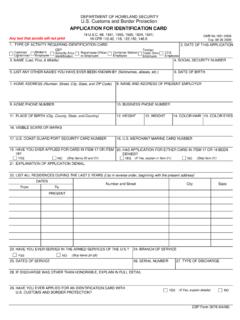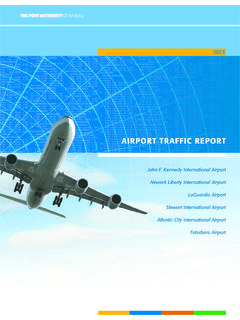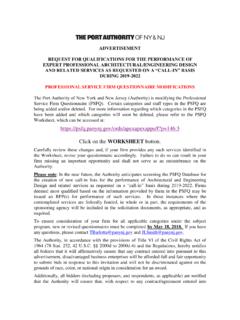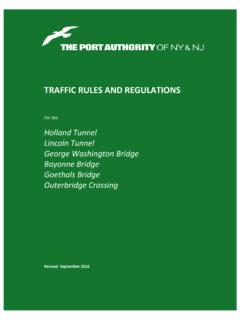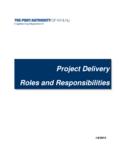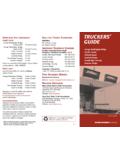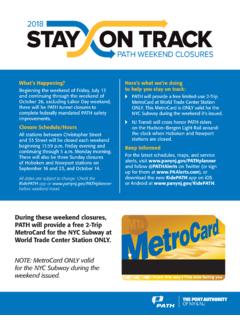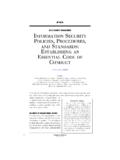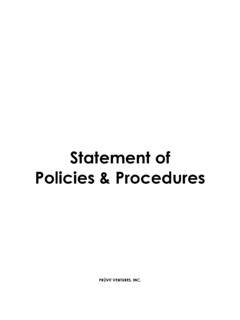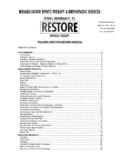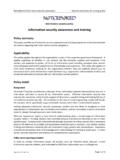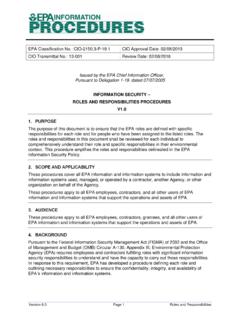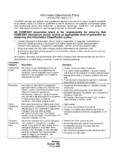Transcription of Information Security Handbook - Port Authority of …
1 I The Port Authority of New York and New Jersey Information Security Handbook October 15, 2008, revised as of April 2, 2018 Copyright 2008, 2013, 2018 The Port Authority of New York and New Jersey No copyright is claimed in the text of regulations or statutes quoted within. ii TABLE OF CONTENTS Page INTRODUCTION.. 1 CHAPTER 1 PORT Authority Information Security ORGANIZATIONAL 2 CHAPTER 2 CATEGORIZATION OF Information .. 4 DEFINITIONS .. 4 GENERAL PROCESS FOR CATEGORIZATION .. 6 TRAINING AND Information REVIEW.. 7 REMOVAL OF CATEGORY DESIGNATION .. 7 CHAPTER 3 Information ACCESS .. 8 APPLICABILITY .. 8 GENERAL CRITERIA .. 8 Information ACCESS CONTROLS .. 9 ACCESS DISQUALIFICATION .. 10 NON-DISCLOSURE AND CONFIDENTIALITY AGREEMENTS (NDAs).
2 10 UNAUTHORIZED DISCLOSURE OF Information .. 11 ACCESS PROHIBITIONS .. 11 BACKGROUND SCREENING .. 12 AUTHORIZED PERSONNEL CLEARANCE LIST .. 12 DEVELOPMENT OF PROTECTED Information PRACTICESAND procedures (PIPP) .. 13 PROCUREMENT STRATEGIES .. 13 iii CHAPTER 4 MARKING, HANDLING, STORAGE, TRANSMITTAL AND DESTRUCTION REQUIREMENTS .. 16 MARKING OF PROTECTED Information .. 16 HANDLING PROTECTED Information .. 18 TRANSMITTAL OF PROTECTED Information .. 18 STORAGE OF PROTECTED Information .. 20 DOCUMENT ACCOUNTABILITY LOG .. 21 REPRODUCTION .. 22 DESTRUCTION OF PROTECTED Information .. 22 Information TECHNOLOGY SYSTEMS HANDLING OF ELECTRONIC Information /DATA .. 23 TRANSMISSION/EXCHANGE OF ELECTRONIC Information .. 23 ELECTRONIC STORAGE .. 24 USER ACCESS DEACTIVATION.
3 25 CHAPTER 5 COMPLIANCE AND MONITORING .. 26 PURPOSE .. 26 AUDITS AND INVESTIGATIONS .. 26 CHAPTER 6 POLICY VIOLATIONS AND CONSEQUENCES .. 28 RESPONSIBILITIES .. 28 VIOLATIONS, INFRACTIONS, OR BREACH OF Information Security PROTOCOLS .. 28 VIOLATION REPORTING, INVESTIGATION AND FACT FINDING .. 28 DISCIPLINARY ACTION ..28 iv CHAPTER 7 Information Security EDUCATION AND AWARENESS TRAINING ..30 PURPOSE .. 30 OVERVIEW .. 30 TRAINING PROGRAM ELEMENTS .. 30 v APPENDICES OF Handbook A - PROTECTED Information B - NON-DISCLOSURE AND CONFIDENTIALITY AGREEMENTS B-1: Non-Disclosure and Confidentiality Agreement with reference to Handbook , Instructions and Example B-2: PA/PATH Employee Non-Disclosure and Confidentiality Agreement B-3: Non-Disclosure Instructions C. BACKGROUND SCREENING CRITERIA THE SECURE WORKER ACCESS CONSORTIUM (SWAC) D CONFIDENTIAL PRIVILEGED DOCUMENT COVERSHEET E - TRANSMITTAL RECEIPT F - GUIDELINES FOR THE STORAGE OF PROTECTED Information G - GUIDELINES FOR THE DISPOSAL AND DESTRUCTION OF PROTECTED Information H - AUDIT procedures I - RESTRICTED ACCESS Information J - AUTHORIZED PERSONNEL CLEARANCE LIST 1 INTRODUCTION This Port Authority of & Information Security Handbook ( Handbook ) establishes guidelines and uniform processes and procedures for the identification, handling, receipt, tracking, care, storage and destruction of Protected Information (as hereinafter defined) pursuant to The Port Authority of New York and New Jersey Information Security Policy (the Policy ) as provided in the 11/20/2008 Board Resolution.
4 This Handbook is intended to be the implementation guideline for that policy. It is also intended to complement the Public Records Access Policy, inasmuch as it further defines certain Information that may be exempt from release under the Records Policy . The guidelines contained in this Handbook are not intended to, in any way, be in derogation of the Records Policy adopted by the Board in April 2016 and as amended December 2017. The Records Policy continues to provide open, timely and uninhibited access to the Port Authority 's (and its component units) public records and reflects the New York Freedom of Information Law ("FOIL") and New Jersey's Open Public Records Act ("OPRA"). This Handbook prescribes requirements and other safeguards that are needed in order to prevent unauthorized disclosure of Protected Information and to control authorized disclosure and distribution of designated sensitive Information , when it is released by The Port Authority of New York and New Jersey (the Port Authority ) either internally or externally.
5 A major underlying principle, on which the Handbook is premised, is that there is a limited universe of Protected Information to which it applies. There is the expectation that prudent, informed and circumscribed judgments will be made by those staff members charged with the responsibility of identifying and properly designating sensitive Information , as is provided for in this Handbook . In this regard, adherence to the Handbook s requirements will help ensure that the necessary care will be constantly and consistently undertaken in order to ensure that mis-designation, or over marking , of Information will be avoided. Another important principle of the Handbook is that access to properly designated sensitive Information is premised on a strict need to know basis. It is the establishment of this need to know that is the essential prerequisite for being granted access privileges.
6 It must be emphasized that possession of a federal Security clearance or other access rights and/or privileges to sensitive Information does not per se establish a need to know for purposes of obtaining access to discrete sensitive Port Authority Information . This principle is equally applicable to the Port Authority and its internal staff as it is to third party individuals and entities, which are given access privileges to Port Authority Protected Information . This Handbook will be amended and updated from time to time as may be appropriate. When appropriate, each Port Authority department, office and/or business unit, as well as contractors/consultants, should create a Protected Information Practices and procedures ( PIPP ) document with additional guidelines for their respective businesses. This will assist staff, and third parties working with the Port Authority , in carrying out the requirements of this Handbook .
7 A PIPP should augment, but may not deviate from, the requirements of this Handbook . The procedures , safeguards and requirements of this Handbook fully apply to all subsidiaries of the Port Authority that deal with, or create, Protected Information . Whenever the term Port Authority is referenced in this Handbook , it should be understood to include and/or cover its subsidiary entities. The Port Authority expressly reserves the right to reject any Information designation and/or to remove/add any and all markings on Information that is not consistent with this Handbook . 2 CHAPTER 1 - PORT Authority Information Security ORGANIZATIONAL STRUCTURE The Port Authority organizational structure for Information Security is as follows: Chief Security Officer (CSO) is responsible for the implementation of Port Authority policy on Security matters, both physical and informational, and for the coordination of Security initiatives throughout the Port Authority in order to assure consistency in practices, procedures and processes.
8 In particular, the CSO works in close collaboration with the Chief Technology Officer, the Security Technology Unit and the Corporate Information Security Officer with regard to their respective areas of Security responsibilities. The CSO acts as the Port Authority s principal liaison on Security related matters with governmental, public and private entities. The CSO works closely with the Law Department, Public Safety Department and the Office of Inspector General on Security initiatives, on compliance with governmental requirements on Security matters, and on issues relating to compliance with the Port Authority s Security policy. Corporate Information Security Officer (CISO) the CISO reports to the CSO in order to assure agency wide consistency on policy implementation. The CISO is responsible for the management, oversight and guidance of the Policy.
9 The CISO works in conjunction with all appropriate Port Authority departments and component units to: (i) formulate practices and procedures concerning Information Security management issues affecting the Port Authority , its operations and facilities; (ii) review, categorize and manage all Port Authority Information consistent with the Port Authority s policy and procedures under its retention policy; and (iii) establish procedures and handling requirements for Port Authority Information based upon its sensitivity designation in order to ensure that the Information is used solely for authorized purposes. Departmental Information Security Officer (DISO) in coordination with the CISO, each department head, and, where appropriate, office head, will designate a staff member to act as DISO in order to ensure compliance with the Policy.
10 The DISO is responsible for management and oversight of Information Security issues for departmental operations and reports to the CISO on Information Security practices and procedures , or issues relating thereto. Additionally, the DISO may perform the Security Information Manager (SIM) functions, if a SIM has not been designated for a department, division, office, unit or project. Each DISO is also responsible for compiling an inventory of all Confidential Privileged Information and, when, appropriate or necessary certain Security -related Confidential Information in their department s possession and/or providing updated listings to the CISO on a periodic basis as established by the CISO. Additionally, when appropriate, the DISO is responsible for approving the departmental Protected Information Practices and procedures ( PIPP ) document and, before authorizing its use, for submitting the PIPP to the CISO for final approval and providing periodic reports to the CISO, as the CISO may require.
